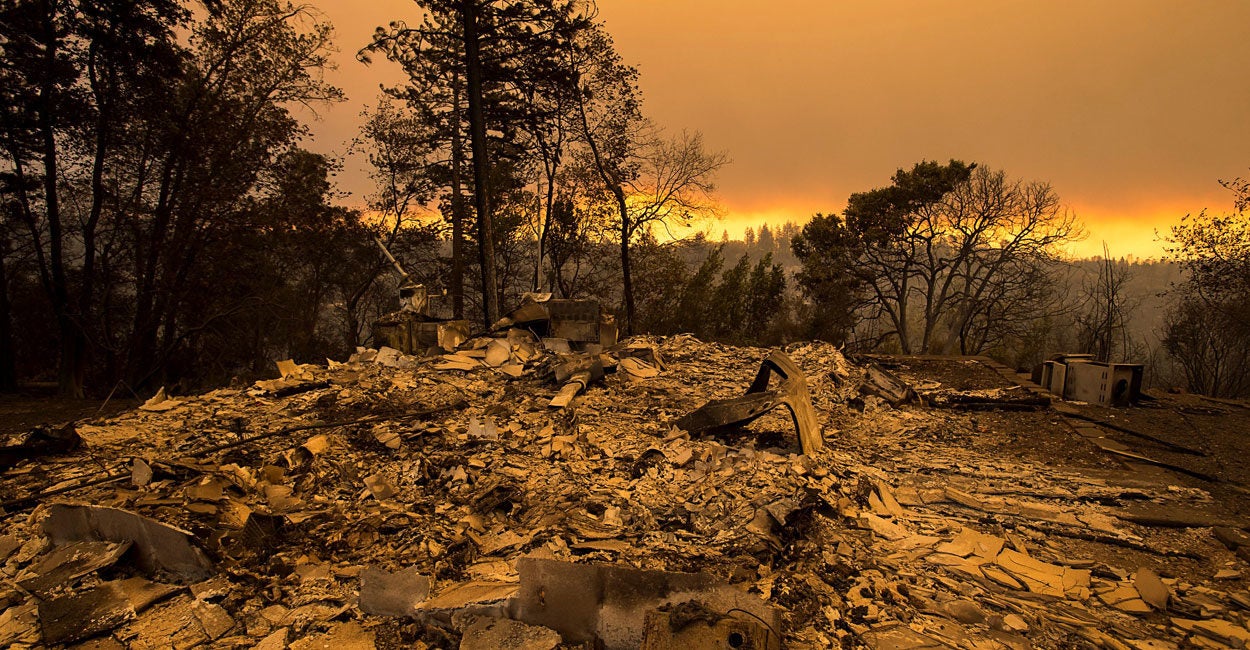Another year, another set of deadly fires burning up California.
The devastation is heartbreaking. The “Camp Fire” has almost completely obliterated the Northern California town of Paradise. It’s now officially the deadliest fire in California history. Over 40 people have died.
https://twitter.com/colincampbell/status/1062380410397691905
The Daily Signal depends on the support of readers like you. Donate now
Heartbreaking photos capture what Paradise looked like before and after the #CampFire ripped through the Northern California town. https://t.co/WVVuN1hyiP pic.twitter.com/vNWRtohKxU
— Brendan Weber (@BrendanNWeber) November 13, 2018
Fire officials estimated that 80% of Paradise, population 27,000, had been obliterated by the Camp Fire https://t.co/jEM8BSgSdR
— The Wall Street Journal (@WSJ) November 13, 2018
This horrific blaze, along with the Woolsey and Hill fires in Southern California, have inflicted untold property damage, laid waste to towns and huge swaths of wildland, and taken dozens of lives. These wildfires are becoming an annual occurrence in the Golden State.
Are these calamities just the “new normal,” as California Gov. Jerry Brown recently said?
They don’t have to be.
President Donald Trump took to Twitter to blast poor land management as a cause of the continual fires.
There is no reason for these massive, deadly and costly forest fires in California except that forest management is so poor. Billions of dollars are given each year, with so many lives lost, all because of gross mismanagement of the forests. Remedy now, or no more Fed payments!
— Donald J. Trump (@realDonaldTrump) November 10, 2018
Some have argued that the kind of land management that Trump is calling for is too costly or simply impossible. Many others argue that the problem is global warming and that Trump is exacerbating the problem through his policy agenda.
As I wrote last year, climate change can’t explain the uptick in large fires we’ve seen in recent years. A 2015 Reason Foundation study noted:
While it is possible that climate change has played a role in increasing the size of fires, the primary cause seems to be forest management practices, which have changed several times over the course of the past 200 years.
The total number of fires has remained steady and even decreased. What’s changed as of late is the uptick in huge infernos that cause widespread devastation.
It’s hard not to see the connection between this increase in wildfires and the land management policy changes that have occurred since the 1970s.
Laws like the National Environmental Policy Act and the Endangered Species Act, according to Rep. Tom McClintock, R-Calif., “have resulted in endlessly time-consuming and cost-prohibitive restrictions and requirements that have made the scientific management of our forests virtually impossible.”
These laws, and others like them, have drastically reduced the amount of forest thinning and controlled burns that used to effectively keep wildland from becoming a danger to people and property.
“One problem for landowners is disposing of deadwood. Dozens of biomass facilities that burn tree parts that can’t be used for lumber have closed due to emissions regulations and competition from subsidized renewables and cheap natural gas,” wrote The Wall Street Journal.
It’s ironic, The Wall Street Journal noted, that while environmentalists support these laws, “destruction from fires imperils species far more than does regulated tree-clearing.”
Former California Assemblyman Chuck DeVore, who now lives in Texas, explained how land management has changed dramatically in the last century and why it’s contributing to the increase in large fires.
https://twitter.com/ChuckDeVore/status/1061416942823763968
Not only have poor policies made land management more difficult for the government, according to DeVore, but they’ve decimated the value of the land to the point that private operators have no incentive to promote an active, healthy land management.
There is now more dead plant matter in California than ever before.
DeVore wrote in Forbes:
Federal lands have not been managed for decades, threatening adjacent private forests, while federal funds designated for forest maintenance have been ‘borrowed’ for fire suppression expenses. The policies frequently reduce the economic value of the forest to zero. And, with no intrinsic worth remaining, interest in maintaining the forest declined, and with it, resources to reduce the fuel load.
An awesome amount of forest made wide swaths of California a tinderbox just waiting for a spark.
According to the USDA Forest Service, there are an estimated 129 million dead trees over a territory of 8.9 million acres across California—a fact that even liberal Vox brought attention to as a major concern. And this doesn’t even account for the shrubs and brush that have been the primary contributors to the most recent fires.
While new challenges have arisen as California and other states grow in population, it’s inexcusable to say that we can’t do as good a job at land management as Americans did a century ago or Native Americans did centuries ago.
There are plenty of ideas to turn around the disaster out West, from abandoning extreme and ultimately misguided environmentalist regulations to devolving land management from federal to state and local authorities, to even more entrepreneurial solutions like creating more privately managed charter forests.
It’s impossible and even undesirable to prevent all fires, but the fact is we can do a better job of taking steps to prevent the worst ones from spinning out of control.
No change can fix this long-term problem over night, but the increasingly large and deadly fires in the West don’t have to be the new normal.
Trump was right to point that out.






























